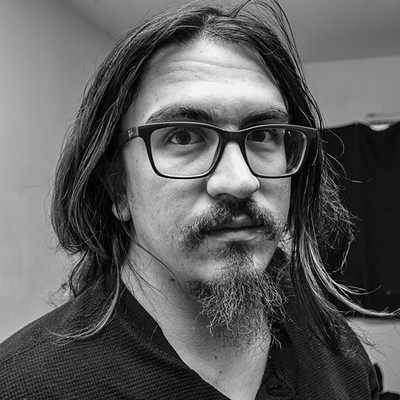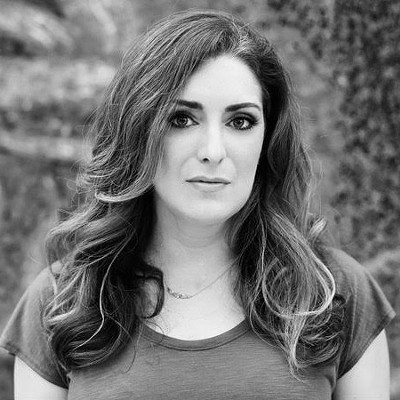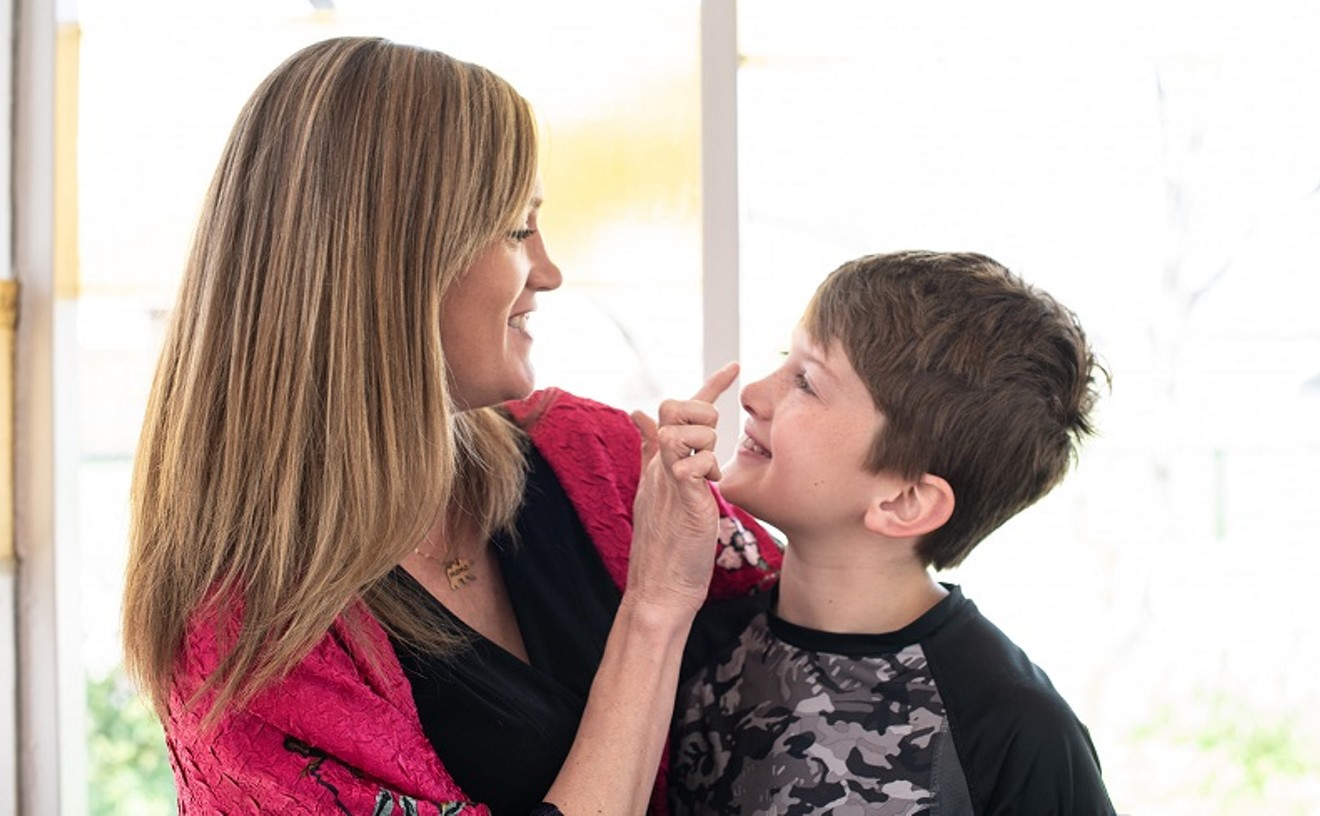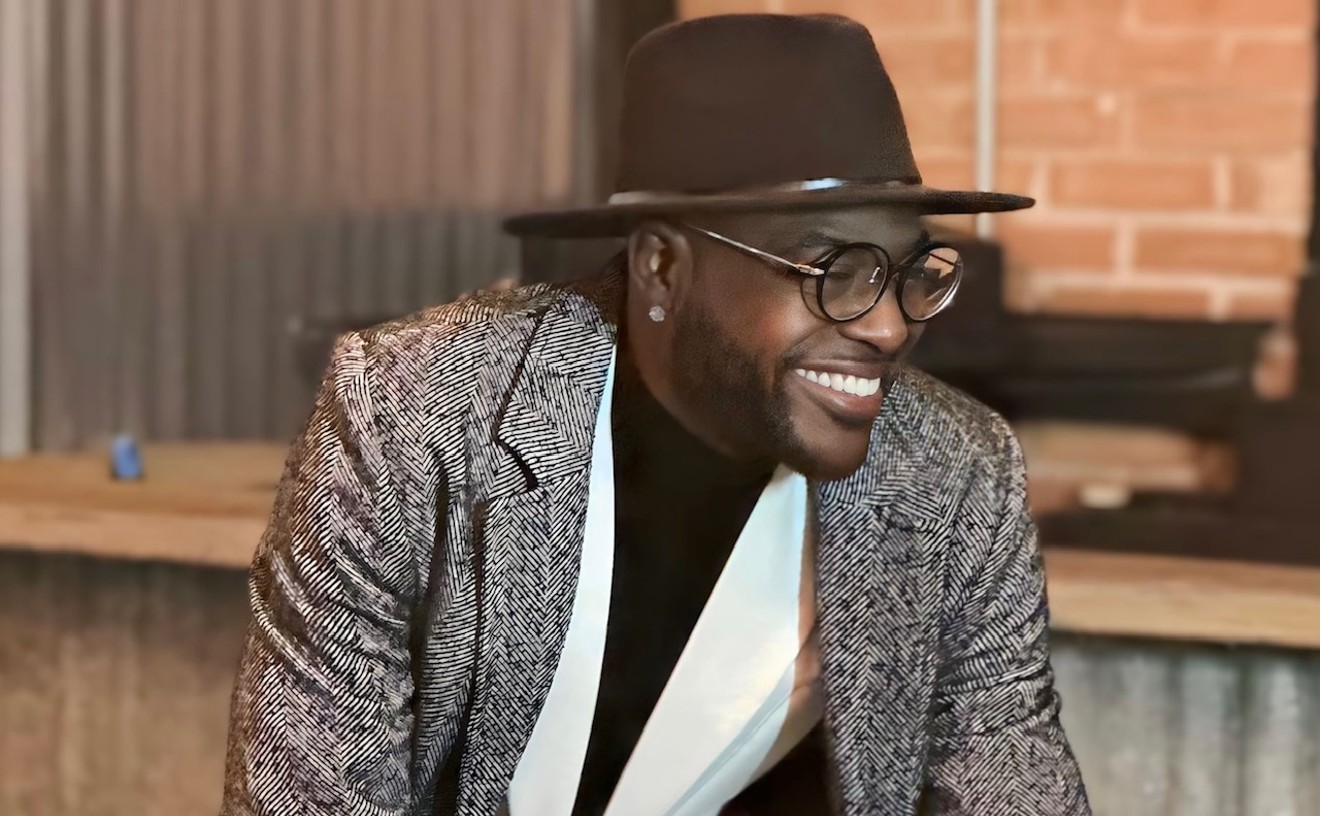Don’s Used Photo Equipment stands amidst a hardened strip of industry on Irving Boulevard, near what’s now the heart of the Design District.
When Don Puckett opened the store in 1997 he started hearing essentially the same thing every day from customers: “This is expensive, does it work?”
“People come in all the time and say, ‘Oh, that’s the $800 piece, does it work?' Well if it works, I’m going to charge you more,” he says. He answered the question so often that “If it works, we charge more” became the store’s unofficial motto.
Don’s Used Photo, which turns 20 this year, is packed nearly floor-to-ceiling with vintage lenses, studio lighting, darkroom equipment, antiquated film and used cameras; more specifically, clunky upright rectangular ones with obscure names like “Ansco SHUR-SHOT,” which no one except the most dedicated photography hobbyist has ever heard of.
Puckett grew up in Hooks, Texas, a dot on a map near Texarkana. As a boy he liked to build things and then take them apart. After high school he entered the Army. While he was stationed in Arizona, people started asking if they could pay for his photos. He used a darkroom on base to process his film so it’d be ready the next day. “If I’d sent it off, it would take two weeks,” he says. “There was no telling where I’d be in two weeks.”
In 1974 he was hired for a small acting part as a sheriff in the shaggy dog film Benji, but he also moonlit as a photographer. “I’d take Polaroids of each set,” he says, so that during reshoots “they could put the cigarettes back in the right place.” His photos would later appear in the film’s posters and advertisements.
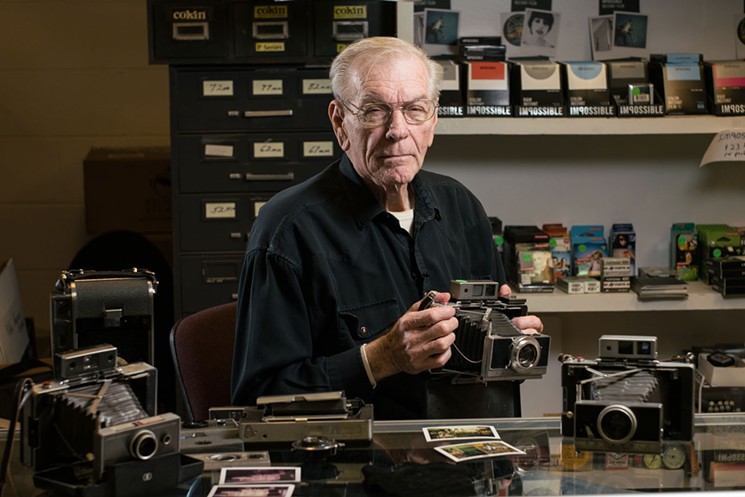
Don Puckett was inspired to build his own cameras while working on the 1974 film Benji.
Daniel Driensky
First, he took Polaroid Camera A. It’s from the 1940s and has a powerhouse lens. Unfortunately they stopped making film for it in 1974. Then he took Polaroid Camera B, newer than Polaroid Camera A and with a body that still functions well but is designed with a cheap plastic lens.
Puckett removed the lens from the older camera and affixed it to the body of the newer one that he could still get film for. Then he removed the viewfinder from yet another camera. Once his Doctor Frankenstein surgery was complete, a literally one-of-a-kind three-in-one hybrid camera had been born. It produced photos that are exquisitely crisp and modern. “At first, one took me three months [to make],” Puckett says. These days he typically finishes one in under four hours.
“He’s the only person that does it like this, in this particular way," his son Todd, now technically the store’s owner, says. “There’s another company that did something similar but they’re out of business now.”
Puckett's idea was born from necessity, but he’s passionate about knowing the obscure details of cameras. “When a regular Polaroid 180, 190, 195 broke, that was it. They couldn’t repair it because there’s a lot of guts in here they had to make parts for,” he says, motioning to a handful of cameras that lay on a glass shelf in front of his swivel chair. “On this one I can take the lens off, send it in and have it repaired. Any 127 lens will probably work. It’ll still fit into that and work.”
Allow us to translate. In 2008 Polaroid announced it was terminating production of instant film and shuttering all but one of its existing factories. But, like the “obsolete” cameras Puckett used to create his first hybrid back in the ’70s, the world had not seen the last of it.
Thanks in large part to the Impossible Project, the brainchild of two dedicated employees of the last Polaroid factory, the hobby of Polaroid photography is more popular than it’s been in decades. In an era of smartphone obsession, young people are now the ones keeping Polaroid alive. Puckett's shop is a vehement supporter and purveyor of Impossible Project.
Before the rise of digital photography, the blocks surrounding Puckett's shop burst at the seam with thriving mom-and-pop camera stores. “Probably 100 within a few miles of where we’re standing,” Todd says. After 2003 they started closing. Today there are a handful of film camera stores still open in Dallas, but they cater to a different demographic. “Everybody else around here only sells new stuff,” he adds.
So what does Puckett think about digital photography? He'll use it, but when he takes a digital picture, he always backs it up with his film camera.
“I’d rather use film because it will last,” he says. “Digital, in a few years will wear out. Film I know years from now my son or my grandchildren will be able to use it. The film will be there. Digital won’t. It doesn’t have a lifetime guarantee.”
In the image “Ride in the Back of a Bicycle Cart” by Frank Lopez, the surroundings are reduced to motion blurs. Trees, shrubs, a river flanking the road and the road itself become beautiful dappled streaks of light and shadow. The subject of the photo, a shadowy figure toting a bicycle cart in Xinjiang Province, China, is anonymous and seen from behind, hunched over handlebars.
Lopez, a professional photographer and educator, took this photo with a pinhole camera, an antiquated tool that he specifically uses to capture a sense of motion. It’s not his only unique tool. He’s become well known in Dallas for his tintype and ambrotype portraits, as well as his pinhole series, which have captured the art deco buildings of Fair Park, the Texas State Fair carnival and travels across China, Vietnam and Korea.
Pinhole camera subjects who move during the 6-second exposure — an “eternity” in photography, he says — are reduced to ghostly silhouettes. “I was capturing breathing, the motion of the natural world.
“Everything is in a frequency, and I always had a romantic notion that a pinhole camera captures that more true to the subject matter than a more sharp-lens camera,” Lopez says. “A pinhole camera gave me an unlimited sense of focus, something inches away from the camera to infinity could be in exact focus. Albeit, something that is moving will be in motion, so you can play with motion.”
A pinhole camera is a primitive image-taking device. It’s essentially a small box with a pinhole that lets in the tiniest amount of light. The film is exposed directly to that light without interference from a lens. “The film is essentially touching the same air as the subject matter, so there is no barrier between,” Lopez says.
The intimacy of film with direct light and open air is a metaphor for how Lopez sees the relationship between subject and artist when using the camera.
“There’s a spiritual sense of when I’m photographing a person and neither of us speaks the same language,” he explains. “These giant digital cameras almost come across as exploitive — there’s a physical barrier between the artist and the subject. With a pinhole camera, that becomes much more collaborative.
“I set the camera down and people come up to look at this little box, this little light-capturing device.” And because of the long exposure and need for the subject to stay still, “it’s a patient, meditative practice, which is much more rewarding than a simple click and walk away.”
Despite the convenience of digital photography at his disposal, Lopez still prefers to make art the old fashioned way — which was the only way when he was learning the trade — spitting vocabulary about “fixers” and “stop baths” and explaining how cyanotype is actually made when you’re not doing it with a smartphone filter.
He fell in love with these antiquated methods in college at East Texas State University in the late 1980s, during a class on pinhole photography and another course called “alternative printmaking.”
“I learned how to make large format negatives by hand, print with precious metals, with gum bichromate and art pigments and different kinds of chemicals,” he says. “The combination of those two classes gave me an overwhelming curiosity in alternative methods for display, for capturing light. It’s a different way of making a hand-crafted image.”
And yet, his fascination with photography reaches back much further. Lopez says he was first captivated by image-making as a kid in Oak Cliff with a Polaroid camera. “My mother pulled up to the side of the road, and I took a picture of a horse — this was when there were still fields and horses in Oak Cliff,” he says. “It was magic because it appeared directly in my hands.”
As the son of a mechanic, Lopez was expected to take over the family business. His father still owns Lopez Auto Services in South Dallas, and he grew up working in the shop, taking things apart and figuring out how they work. “I learned how to rebuild carburetors and engines,” he says.
That ended up being invaluable to his budding photography practice. “I’m good with my hands, and I was always inquisitive about how to make things, and how to adapt things. I purchased my first camera in high school, and I taught myself how to make a black-and-white print, I taught myself how to use a darkroom,” he says. “I was going to take over the family business, but I kept being pulled back.”
Lopez found his school program at East Texas State — the best in the region, he says, and declared a major that day. “I had a fun time photographing, but I didn’t know you could make a living as a photographer. It was largely by accident that I discovered I could be a photographer, and I haven’t looked back since.”
For the past 11 years, Lopez has been teaching photography to high school students at Greenhill School, which has an internationally award-winning photography program. He’s the instructor for a number of classes like darkroom, digital, experimental and “iPhoneography.”
Given his love of experimentation, maybe not surprisingly, Lopez is teaching a cross-disciplinary course with chemistry teacher, Chad Bittenbender, built on the premise of “understanding what the chemistry does, explaining it scientifically and then making art.”
“The two classes that really drive me are my honors program and the chemistry of photography class.” He explains, “It grew out of me going by the science building many years ago and borrowing chemicals, and [Chad] always had a fascination with photography.”
And his teaching isn’t limited to high school students. Lopez gives small-group workshops on how to create images on ambrotype (glass) and tintype (metal) from scratch, including learning how to shoot, light, develop, fix and varnish the finished product in a fully hands-on experience.
This spring, Lopez is curating an experimental photography exhibition at JM Gallery that will run from May 13 to June 24. It’s a group show including his newest work.
He’s been working with Polaroid film — bleaching, bending, tearing and scratching the film to create abstract expressionist works. He says his students’ explorations in experimental photography have inspired him to do more experimenting as well. “I’m making these forms and shapes that become about the chemistry itself and not about a particular subject,” although the basis for the series are still lifes of found objects in Fair Park during the time that Lopez lived there.
Despite his prominence in imagemaking, Lopez says he is more interested in the lofty goal of “redefining the role of photography in society. We can go to Instagram and do all of these cool filters; up until now, you had to have a degree in photography to perform a lot of the functions that are now a keystroke away. As an artist, I’m trying to see if we can find a new digital language to reinterpret our materials, and how we look at that role in photography.
“I love that when people come into a gallery show of my work, they’re awed because it’s no longer something they see on a tiny screen. My work is an experience.”
If you’ve been to the Nasher Sculpture Center recently, you have probably already seen Shamsy Roomiani’s work — and noticed that it’s for sale.
Her Mushroom Herbarium Sculptures, as well as Howdy Doodles — a collaborative coloring book with other local artists, are on offer in the Nasher gift shop. She’s also been featured as “Artist at Work” for the Nasher Kids Club and will be included in the Nasher’s 2017 Great Create event.
Roomiani loves traditional mediums of art, but she has built a name for herself by experimenting with chemical compounds used to make cyanotypes. “I love cyanotypes because they echo like a photograph but seem so delicate like a whisper of a memory,” Roomiani says.
Similar to the dark room process, cyanotypes are coated in a photosensitive solution, layered with a negative or object and then exposed to UV light. After undergoing a water bath, the print begins to oxidize and turn a distinct Prussian blue. “This specific color is prevalent in most of my work whether it be in nature prints, cyanotypes or painted sculptures,” Roomiani says.
“I am drawn to the often overlooked and particularly unusual textures in my surroundings,” she says. That may explain why Shamsy's greatest inspiration comes from plants. Her latest solo show at Eastfield College, Botanica Spectrum, features cyanotypes, illustrations and terrarium-style sculptures adorned with bright-colored crystals. Iris Bechtol, the Gallery director at Eastfield College, describes her as “an artist meets naturalist meets mystic.”
The Austin-born, Richardson-raised artist relocated to a 1920s Lakewood bungalow after graduating from the University of North Texas with a BFA in printmaking and a BA in marketing in 2007.
Her artwork and handmade goods are also sold at shops such as Jade & Clover and We Are 1976. “When local businesses support artisans, they invest in our community,” Roomiani says. “Local artists give our city character and the relationships we build together with local businesses strengthen community cohesiveness. It is a beautiful partnership and it makes us all proud.”
In addition to partnering with local businesses and museums, Roomiani has also collaborated with dozens of other Dallas artists. Last September she contributed to a group show, Plantbased, at The Platform with Will Heron, Erik Rodriguez and 10 other local artists. In November, she took part in Super Fantasy Mercado, a collaborative interactive installation dressed as a pop-up store in a Garland flea market with Brent Ozaeta, Taro Waggoner and Mylan Nguyen.
Contributing to the local art scene is important to Roomiani, but that doesn’t stop her from participating in projects outside of the 214. Last October she was part of a show at Printed Matter in New York City for the sixth issue of Hey Lady, a feminist collaborative art quarterly by Regina Shilling.
At the end of the day, the most rewarding feeling for Roomiani is witnessing that moment of mutual understanding in the eyes of someone viewing her work. “We have so much negativity raining down on us and constantly yelling at us in our lives, especially lately,” Roomiani says. “I want to put work into the world that offers the viewer at least one second of the day to be still, find quietness and perhaps feel a little less stressed.”
Cassandra Black’s parents’ photography shop, Photographique, has been serving the Dallas area for more than three decades. After growing up in the shop, Cassandra explored her own artistic talents in college.
She moved back to the family business during the early-2000s decline of film photography.
“At the time we had kind of pared down the shop and most of our employees were gone, and it just was a hard time,” Cassandra says. To help out, she taught herself a skill that’s helped keep Photographique open: photo restoration.
“[Restoration] kept us alive when film went away,” Paul Black, Cassandra’s father, says. “We do pretty amazing stuff, and that’s why we stayed alive. If all those other guys had done that they’d still be in business too. It’s highly specialized.”
At one time Photographique was a much bigger business. They hosted exhibitions, rented studio space to professional photographers and were able to track their business by the seasonal cycle of graduations and weddings, birthdays and funerals. But Paul says things started to change in 2003.
“We were almost over, a lot of people in our business just shut the doors,” Paul says. “Cooters closed, Wolf Camera closed a lot of their stores; people just stopped shooting film and getting prints, from about 2003 thorough the next 10 years.”
Paul and his family moved to Dallas where he worked for the Polaroid Corp. for over a decade. There he conducted shelf-life studies, buying the product off the shelf and seeing how the film performed over time and assuring its quality. When the Polaroid facility in Dallas finally closed, Paul was offered a new position but opted to stay in Dallas and start Photographique. Then, as Paul says, “the years turned to decades.”
Restoring the past saved Photographique from becoming history. Film restoration is a painstakingly meticulous process. Originally done with paints, brushes and elbow grease, photo restoration has always been a highly specialized craft, which made finding qualified restorationists difficult for the struggling company.
If the ability to hold on to a memory and archive our own histories is what makes the art of photography so magical, than the ability to restore these treasures must be some higher sorcery.
“A lot of the restoration we do is from really old photographs which [have] the most horrible [editing] you’ve ever seen in your life. That’s what these guys were doing around the turn of the last century, from 1890 to 1920,” Paul said. “It’s all hand done; photographs come in and there’s no photograph left on it, it’s all drawn.”
In the late 19th and early 20th centuries photographers made edits by hand, using brushes, inks and oils to do everything from hand coloring their printed images to scraping away parts of a negative to remove details. The variable quality and sensitivity of photographic materials of the day meant these images faded over time, sometimes leaving only the faint outline of the original image.
Photographique uses a blend of modern and traditional techniques to achieve the best possible re-creation of an image. Cassandra often starts with a photograph duplicate of the damaged image taken with a film camera. That film is then scanned into a computer, touched up or fully recreated, and finally reprinted and packaged.
“Being able to do Photoshop and then being able to restore something is a different skill,” Cassandra says. “What we try to do is to take what the original image would be like, and recreate that. The more information we can get from a client the more well-rounded a piece we can make.”
The restoration process involves more than technical skills or computer assistance. Cassandra says that much of the work of restoration comes from speaking with the client, in order to recreate the image of their dreams.
“We really try to do what people want, and we try to make them happy because they’re bringing it to us because they believe and trust that we’re going to take care of their treasured heirloom,” she says. “And not only that, but recreate it.”
Clients come into Photographique with all manner of damaged and destroyed photos, some still stuck to the glass of their former frames after suffering severe water damage. There are photos from the 19th century, so worn and faded that hardly any of the actual photograph remains.
“It’s kind of overwhelming when you feel like you have an idea of what this image looks like in your mind and you give it to us to restore and you get it back and it’s just completely changed and restored to what you never even thought was there,” Cassandra says. “It’s pretty amazing.”
The staff at Photographique consider themselves perfectionists, and Cassandra’s stunning recreations are so powerful at times that the register is fully stocked with tissues. “For us that’s really rewarding, to be able to contribute to someone’s happiness and generate something that has become an heirloom that can share with generations to come,” Cassandra says. “We like to make miracles happen.”







